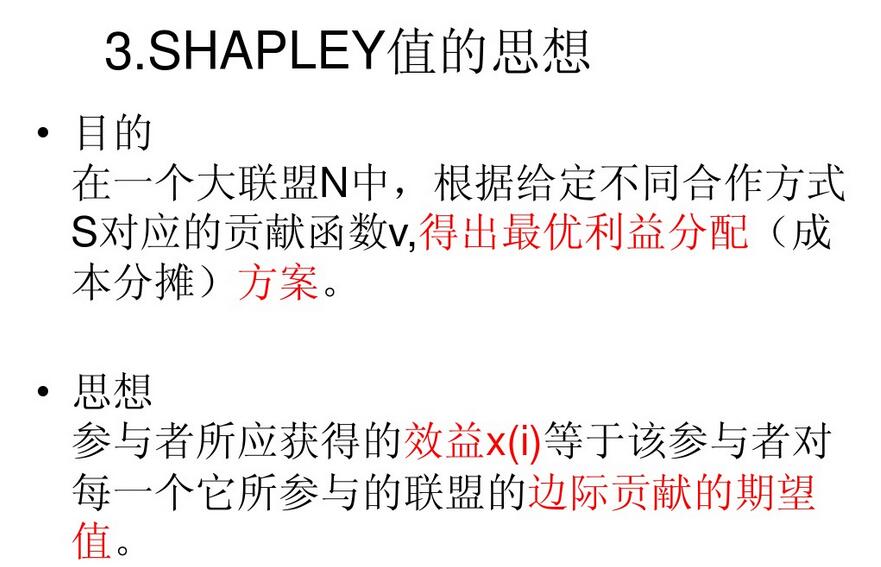基於Shapley值進行聯盟成員的利益分配體現了各盟員對聯盟總目標的貢獻程度,避免了分配上的平均主義,比任何一種僅按資源投入價值、資源配置效率及將二者相結合的分配方式都更具合理性和公平性,也體現了各盟員相互博弈的過程。但Shapley值法的利益分配方案尚未考慮聯盟成員的風險分擔因素,實質上隱含著各盟員風險分擔均等的假設,因此,對於聯盟成員風險分擔不等或風險分擔存在較大差異的狀況,需要根據風險分擔大小對Shapley值法的利益分配方案做出適當的修正。另需要注意利用Shapley值法進行利益分配應具備的前提條件是:要求每個參與人對在不同聯盟組合狀態下的利益要有一個較為準確的預期;此外,還要對這種複雜的計算方式有一個清楚的了解。知識聯盟的總產出有時可能是不確定的,不同聯盟組合狀態下的收益也可能是不確定的,這會在一定程度上影響Shapley值法的套用。對於總效用不確定的情況,為了獲取一個比較合理的不同聯盟組合狀態下的效用值,可以採用AHP法、ANP法、模糊數學等綜合評價方法來估算各種聯盟組合狀態下的可能效用值,從而獲得shapley值法所需要的數據,再進行具體利益分配上的計算。
基本介紹
- 中文名:Shapley值法
- 外文名:Shapley Value Method
- 所屬學科:數學
- 所屬問題:合作對策問題
- 相關概念:n人合作對策
- 提出者:L.S.Shapley
- 提出時間:1953年
基本介紹,程式表達,
基本介紹
在社會或經濟活動中,兩個或多個實體,例如個人、公司、國家等,相互合作結成聯盟或者利益集團,通常能得到比他們單獨活動時獲得更大的利益,產生一加一大於二的效果。然而,這種合作能夠達成或者持續下去的前提就是,合作各方能夠在合作的聯盟中得到他應有的那份利益。那么,如何才能做到合理地分配合作各方獲得的利益呢?我們先來看一個簡單的例子。
【問題1】 甲、乙、丙三人合作經商。倘若甲、乙合作可獲利7萬元,甲、丙合作可獲利5萬元,乙、丙合作可獲利4萬元,三人合作則獲利10萬元,每人單幹各獲利1萬元。問三人合作時如何分配獲利?
很顯然,利益分配時,三人獲利總和應為10萬元。設甲、乙、丙三人分配獲利為 ,則有
,則有


三人中如果誰獲利小於1萬元,則他就會單幹,不會加入這個聯盟。如果 不成立,甲和乙就會組成一個小的聯盟,而把丙拋在一邊。
不成立,甲和乙就會組成一個小的聯盟,而把丙拋在一邊。

但是,這個系統有無窮多組解,例如 ,甚至是(3,5,2)。很顯然,站在乙或丙的角度,和甲合作都可以獲得更大的利益,換言之,甲在他所參與的合作中貢獻最大;同理,乙次之,丙貢獻最小。因此,像(5,3,2),
,甚至是(3,5,2)。很顯然,站在乙或丙的角度,和甲合作都可以獲得更大的利益,換言之,甲在他所參與的合作中貢獻最大;同理,乙次之,丙貢獻最小。因此,像(5,3,2), 都是合理的解。哪一個更合理?因此應該有一種圓滿的利益分配方法。
都是合理的解。哪一個更合理?因此應該有一種圓滿的利益分配方法。


這類問題稱為n人合作對策。L.S.Shapley在1953年給出了解決該問題的一種方法,稱為Shapley值法。
下面先給出合作對策的一般模型。記 為n個合作人的集合。若對於
為n個合作人的集合。若對於 的任何子集
的任何子集 都有一個實數v(s)與之對應,且滿足下列條件:
都有一個實數v(s)與之對應,且滿足下列條件:



(1) ,其中
,其中 為空集。
為空集。


(2)對於任意兩個不交子集 ,都有
,都有 ,則稱v(s)為定義在
,則稱v(s)為定義在 上的一個特徵函式。
上的一個特徵函式。



在實際問題中,v(s)就是各種聯盟的獲利,而第二個條件表明任何情況下合作至少總比單幹或者小團體的合作來得有利。合作對策就是需要確定每個人獲得的利益 ,或者對全體成員來講就是向量
,或者對全體成員來講就是向量 。按照前例的分析,我們知道合理的分配需要滿足
。按照前例的分析,我們知道合理的分配需要滿足




上述的提法中實質上沒有什麼限制,這樣我們總可以找到多個解。所以,必須有一些有關合理性的限制,在諒限制下,尋找合理的對策才是有意義的。
Shapley給出了一組對策應滿足的公理,並證明了在這些公理下合作對策是唯一的。
【公理1】(對稱性)設 是
是 的一個排列,對於
的一個排列,對於 的任意子集
的任意子集 ,有
,有 。若在定義特徵函式
。若在定義特徵函式 ,則對於每個
,則對於每個 都有
都有 。
。








這表示合作獲利的分配不隨每個人在合作中的記號或次序變化。
【公理2】(有效性)合作各方獲利總和等於合作獲利:

【公理3】(冗員性)若對於包含成員i的所有子集s都有 ,則
,則 。其中
。其中 為集合s去掉元素i後的集合。
為集合s去掉元素i後的集合。



這說明如果一個成員對於任何他參與的合作聯盟都沒有貢獻,則他不應當從全體合作中獲利。
【公理4】(可加性)若在 上有兩個特徵函式
上有兩個特徵函式 ,則有
,則有



Shapley證明了滿足這四條公理的 是唯一的,並且其公式為
是唯一的,並且其公式為










程式表達
Shapley值法寫成程式就是:
function shapley
n= input(’Number of cooperators:’);
for j=1:n,
nam{j}=input (['Name of cooperator' num2str(j)’:’] ,’s’);
end
for k =1:2^n-1,
w{k}=abs (dec2bin(k)- 48);
w{k}= [zeros(1,n-length(w{k})) w{k}];
fprintf ('The profit for cooperator’);
for j= I:n,
if w{k}(j)==1,
fprintf(’% s', nam{j});
end
end
p(k)=input(’:’);
end
fprintf ('\nIf they cooperate,then \n');
for j=1:n,
x(j)=1/n*p(2^(n-j));
for k =1:2^n-1,
if w{k}(j)==0,
s = sum(w{k})+ 1;
ww =1/s/nchoosek(n,s);
x(j)=x(j)+ww* (p(k+2^(n-j))一p(k));
end
end
fprintf ('The profit for % s is : % f. \n, nam{j},x(j));
end

